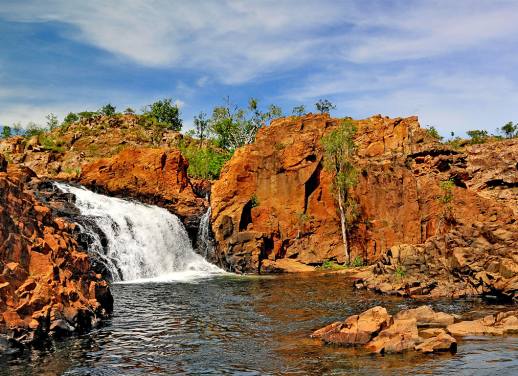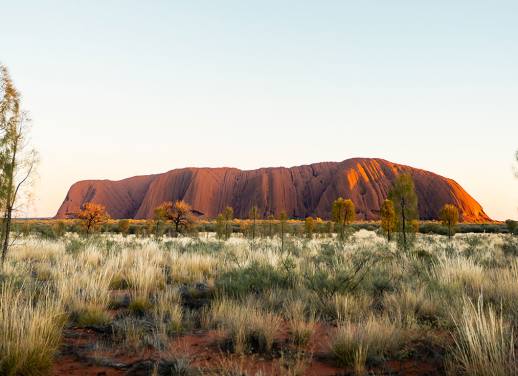On a trip to explore her own backyard, Melbourne writer Chalice Faehse connects with the Northern Territory’s Aboriginal people and shares why cultural sensitivities prevent her from taking photos and retelling their stories.
The rusty oranges and reds of the landscape made way for the deep greens of the natural waterhole. We were saved.
With sweat dripping into my eyes as we hiked up a rocky incline in Australia’s Northern Territory, I asked myself why I chose to travel the Top End. Even in autumn, this place reaches the mid-30°Cs, and there’s hardly a cloud in the sky. But sliding into the cool swimming hole like a lazy crocodile, I remembered why. This place is rich – in beautiful landscapes and wildlife, but also in Aboriginal culture and history.



However, there are cultural nuances to be aware of when visiting Country as an outsider that prevent me from sharing what I learned and saw there. Some stories just aren’t mine to tell. Some photos aren’t mine to take.
Aboriginal and Torres Strait Islander peoples often encourage tourists to engage with their vast histories, cultures and practices – but it needs to be done respectfully when visiting rural areas and First Nations communities.
For example, some sacred sites in Kakadu National Park strictly forbid visitors from taking photos or reproductions of their sacred knowledge. Like their cultural knowledge and stories, which are passed down by word of mouth to ensure they stay within their mob (the Aboriginal term for a group of people associated with a particular place), some things are not for outsiders. And rightly so.
This is one of the reasons I’m grateful to be exploring the Top End with Intrepid – an adventure-travel company with a keen awareness of travelling through Indigenous areas responsibly, with a focus on cultural connection.
So, while I don’t want to gatekeep the best spots in the NT (Florence Falls is a must, trust me), I won’t share everything about my trip. Of course, I can tell you about the epic Yellow Water Cruise along Kakadu’s billabong, where you’ll see hundreds of birds as they herald the sunrise. But you’ll need to see the snapshot for yourself and hear the stories that accompany the cool morning landscape directly from the mouth of the oversharing captain Dennis. Born and bred in the Top End, his jokes and cultural storytelling are much better when heard first hand.
Read more: How to travel on Country in Australia



Why I didn’t take photos
Aboriginal and Torres Strait Islander culture has been alive for at least 65,000 years. This kind of number is almost impossible to comprehend – but ancient rock-art sites, like those in Kakadu National Park, provide some context.
Weaving our way through the Nourlangie and Ubirr sites, my small group found kunbim (rock-art paintings) of fish, kangaroos, hunters, handprints and Creation Stories.
At one cliff wall, surrounded by eucalyptus trees, we stopped in front of the famous painting of Namarrgon: the Lightning Man. Our leader Tracy, a local Darwinian guide, got goosebumps while telling us that this is a sacred site.



We all instinctively hushed as we approached the figure painted in white. But my camera roll remains empty. I can’t show you more than these words, because this site, along with a few others around Kakadu’s outdoor gallery, is strictly for your eyes and not to take away with your lenses.
Rock-art sites hold deep cultural and spiritual importance, making them equivalent to sacred scripture for Traditional Custodians. Photography can compromise the privacy and protection of cultural knowledge that is not meant for wider public dissemination. Taking photos is seen as disrespectful and, in addition to that, may damage the fragile art or the surrounding environment, just like using your flash in the Louvre.
Like the Lightning Man, some rock art depicts faces or humanoid figures, and Aboriginal culture is pretty strict when it comes to reproductions and images of its people (especially the deceased).
When taking photos of people, even a likeness in a story, you must always ask for direct permission. Since Namarrgon can’t give us permission from the skies, you’ll just have to see him with your own eyes.
Read more: Try stand-up paddleboarding led by a First Nations guide



Why I can’t retell stories
This goes for written content, too. Perhaps the biggest highlight of my trip was meeting Norma, an Aboriginal woman in her 50s with white/blonde hair, deep smile lines and kind, brown eyes.
Our small group visited her brother-in-law’s property in Lambells Lagoon to see how they live off the Land. With her soft, gentle voice, she welcomed us onto the bushy property and told us about her life as we walked along the water’s edge (at a safe distance from the resident croc, who they have a ‘you don’t hunt us, we won’t hunt you’ agreement with).
She moved away from her mob to work in medicine and try out city life in Brisbane. But after a health scare, Norma realised that what her soul really yearned for was to reconnect with family and Country.
As she told us about how palm seeds are linked to meteorites, we all learnt about the role of ‘consequence stories’. Often referring to the ongoing devastating impacts of colonisation, past and present, these stories are used to teach children about growing up on Country. From little things like how to be conscious of waste to avoiding dangerous wildlife, consequence stories are a poetic way to pass down the dos and don’ts of Aboriginal society.
If you want to know more about how throwing a seed on the ground can lead to meteor showers, you’ll just have to visit Norma yourself. To hear these stories in the landscapes to which they’re connected, from a person whose ancestors first told them, is special. More than special, it’s imperative.
The only way to heal our Land as Australians is to uplift the voices of First Nations’ peoples – and sometimes, this can be as simple as listening to stories from those generous enough to share them. The roots of these tales lie in their connection to Country, and often, aren’t shared outside of specific cultural groups at all. With a culture so rich, diverse and sacred, it’s a privilege to hear some of these stories from a caretaker of the Land.
Additionally, Aboriginal and Torres Strait Islander stories are often only passed down through voice and song, so it would be wrong and taboo to share them here, in writing. And you don’t want to hear them from me anyway, when like Dennis, Norma is such a good storyteller.
Read more: Exploring the Great Ocean Road with a First Nations creative



Why I can’t pass on skills
Norma also showed us how they utilise the plants on their property, what bushtucker they eat, what they use for medicine and how they hunt. She explained that although they still duck to the shops like most of us do, they try to live off the land as much as they can.
As well as trying our hand at spear throwing (let’s just say, the wallabies are safe with me), our group also learnt how to weave using the fronds of waterside plants. I may not be able to share how to make baskets and dilly bags (what Norma uses to collect bushtucker and bush medicine) out of simple plant fibers, but I can tell you how impressive it was to watch an expert at work. As Norma’s nimble fingers stripped each frond of its fibers, flicked the tip until it made a ‘zzzrrrrpppp’ sound and twisted them all together so they had the strength of thick rope… we all came to appreciate the resourcefulness and skill it takes to live sustainably.
When we arrived in Lambells Lagoon, we saw only sparse trees, dense bush, a scuttling lizard in the grass, a dangerous billabong and a humble house surrounded by desert. When we said our goodbyes to Norma, we saw food sources, medicine, important resources, spiritual connection and community – and felt an entirely new appreciation for the land around us. When we gave our heartfelt thanks to Norma, we all yearned to spend longer with her, learn more from her, listen to her stories. As she did, we yearned to return to Country.

Connections in Country
At first, when travelling through Aboriginal and Torres Strait Islander lands, it can feel frustrating to not document the best bits of your trip, especially when we’re all now so accustomed to capturing every moment of our lives. How will I remember the sacred rock-art site without a photo? How will I remember every detail of the stories I was told without writing them down?
But once I realised I wasn’t there to document everything on my phone, but just to experience it, to learn from it, to feel it and be at one with it – the sweat, the crocs, the abundant birdlife, the plants, the red dirt, the bugs, the moon, the bush – I felt liberated.
That feeling of connection really is the best bit about travelling the Northern Territory – meeting the Custodians whose ancestors have lived there almost as long as time itself. You can’t get that from reading a story alone. You have to see it, feel it and learn it for yourself.
Chalice Faehse travelled on Intrepid’s Kakadu, Katherine and Litchfield Explorer trip which visits the Traditional Custodians of the land at Kakadu National Park and gains insight into the First Nations’ customs and traditions of the Northern Coast Wetland region.




